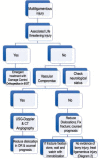Practice Guidelines for the Management of Multiligamentous Injuries of the Knee
- PMID: 28966377
- PMCID: PMC5609375
- DOI: 10.4103/ortho.IJOrtho_228_17
Practice Guidelines for the Management of Multiligamentous Injuries of the Knee
Abstract
Background: Multiligamentous injuries of knee remain a gray area as far as guidelines for management are concerned due to absence of large-scale, prospective controlled trials. This article reviews the recent evidence-based literature and trends in treatment of multiligamentous injuries and establishes the needful protocol, keeping in view the current concepts.
Materials and methods: Two reviewers individually assessed the available data indexed on PubMed and Medline and compiled data on incidence, surgical versus nonsurgical treatment, timing of surgery, and repair versus reconstruction of multiligamentous injury.
Results: Evolving trends do not clearly describe treatment, but most studies have shown increasing inclination toward an early, staged/single surgical procedure for multiligamentous injuries involving cruciate and collateral ligaments. Medial complex injuries have shown better results with conservative treatment with surgical reconstruction of concomitant injuries.
Conclusion: Multiligamentous injury still remains a gray area due to unavailability of a formal guideline to treatment in the absence of large-scale, blinded prospective controlled trials. Any in multiligamentous injuries any intervention needs to be individualized by the presence of any life- or limb-threatening complication. The risks and guarded prognosis with both surgical and non-surgical modalities of treatment should be explained to patient and relations.
Keywords: Arthroscopy; Orthopedics; arthroscopy; bi-cruciate injury; knee dislocation; knee injury; multiligament injury; multiligamentous injury; systematic review.
Conflict of interest statement
There are no conflicts of interest.
Figures
Similar articles
-
Multiligamentous knee injuries - surgical treatment algorithm.N Am J Sports Phys Ther. 2008 Nov;3(4):198-203. N Am J Sports Phys Ther. 2008. PMID: 21509121 Free PMC article.
-
Comparison of KD3-M and KD3-L Multiligamentous Knee Injuries and Analysis of Predictive Factors That Influence the Outcomes of Single-Stage Reconstruction in KD3 Injuries.Orthop J Sports Med. 2018 Sep 19;6(9):2325967118794367. doi: 10.1177/2325967118794367. eCollection 2018 Sep. Orthop J Sports Med. 2018. PMID: 30246039 Free PMC article.
-
Investigation of multiligamentous knee injury patterns with associated injuries presenting at a level I trauma center.J Orthop Trauma. 2013 Apr;27(4):226-31. doi: 10.1097/BOT.0b013e318270def4. J Orthop Trauma. 2013. PMID: 22955332
-
How do surgically treated multiligamentous knee injuries affect overall complication rate and especially stiffness? A systematic review.Knee Surg Relat Res. 2025 May 1;37(1):18. doi: 10.1186/s43019-025-00270-9. Knee Surg Relat Res. 2025. PMID: 40312390 Free PMC article. Review.
-
Timing of Surgery & Rehabilitation After Multiligamentous Knee Reconstruction.Curr Rev Musculoskelet Med. 2024 Nov;17(11):476-483. doi: 10.1007/s12178-024-09923-w. Epub 2024 Aug 23. Curr Rev Musculoskelet Med. 2024. PMID: 39174807 Free PMC article. Review.
Cited by
-
Epidemiological Study on Multiligament Knee Injuries.Rev Bras Ortop (Sao Paulo). 2022 Mar 11;57(4):675-681. doi: 10.1055/s-0041-1731798. eCollection 2022 Aug. Rev Bras Ortop (Sao Paulo). 2022. PMID: 35966442 Free PMC article.
-
Outcomes of one-stage reconstruction for chronic multiligament injuries of knee.Knee Surg Relat Res. 2021 Jan 7;33(1):3. doi: 10.1186/s43019-020-00083-y. Knee Surg Relat Res. 2021. PMID: 33413666 Free PMC article.
-
Arthroscopic Reconstruction of Posterior Cruciate Ligament with Embedded Tibial Tendon Bolt.Orthop Surg. 2021 Apr;13(2):592-598. doi: 10.1111/os.12855. Epub 2021 Jan 20. Orthop Surg. 2021. PMID: 33474839 Free PMC article.
-
Upsurge of Sports Injuries and Their Treatment.Indian J Orthop. 2017 Sep-Oct;51(5):485-486. doi: 10.4103/ortho.IJOrtho_431_17. Indian J Orthop. 2017. PMID: 28966370 Free PMC article. No abstract available.
-
Investigating the Ligament Involvement in High-Energy and Polytraumatic Multiligament Knee Injuries Compared With Low-Energy or Isolated Injuries.Orthop J Sports Med. 2025 Feb 6;13(2):23259671241312251. doi: 10.1177/23259671241312251. eCollection 2025 Feb. Orthop J Sports Med. 2025. PMID: 39949631 Free PMC article.
References
-
- Rihn JA, Groff YJ, Harner CD, Cha PS. The acutely dislocated knee: Evaluation and management. J Am Acad Orthop Surg. 2004;12:334–46. - PubMed
-
- Hoover NW. Injuries of the popliteal artery associated with fractures and dislocations. Surg Clin North Am. 1961;41:1099–112. - PubMed
-
- Jones RE, Smith EC, Bone GE. Vascular and orthopedic complications of knee dislocation. Surg Gynecol Obstet. 1979;149:554–8. - PubMed
-
- Burrus MT, Werner BC, Griffin JW, Gwathmey FW, Miller MD. Diagnostic and management strategies for multiligament knee injuries: A critical analysis review. JBJS Rev. 2016;4:1–9. - PubMed
LinkOut - more resources
Full Text Sources
Other Literature Sources


